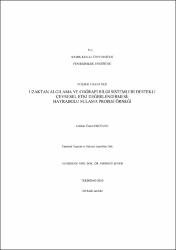| dc.contributor.author | Ergüven, Gökhan Önder | |
| dc.date.accessioned | 2017-05-03T08:54:27Z | |
| dc.date.available | 2017-05-03T08:54:27Z | |
| dc.date.issued | 2010 | |
| dc.identifier.uri | https://hdl.handle.net/20.500.11776/634 | |
| dc.description.abstract | Bu çalışma, Karaidemir Barajı Sulama Kooperatifi tarafından işletilen Hayrabolu Sulama Şebekesi'nin Uzaktan Algılama (UA) ve Coğrafi Bilgi Sistemi (CBS)'nden yararlanılarak, Çevresel Etki Değerlendirme (ÇED)'sini yapmak amacıyla gerçekleştirilmiştir. Yapılan anket çalışmasında, özellikle çeltik gibi su ile çokça temasta bulunan çiftçilerin sulama suyu kalitesi nedeniyle ciltlerinde problem olduğu belirtilmiştir. Su kaynağı ve ana tahliye kanalından alınan örneklerde su kalitesi C3S1 olarak saptanmıştır. Şebekeye ait 2000-2009 yıllarına ilişkin taban suyu seviyeleri ve tuzluluk değerleri incelenmiş ve en kritik taban suyu seviyesi 2006 yılı Haziran ayında % 28.8 olarak saptanmıştır. Tuzluluk açısından ise en kritik değer 2008 yılında 6850 µhos/cm olarak bulunmuştur. Sulama şebekelerinde yapılan ÇED çalışmaları, şebekenin sağlıklı bir şekilde çalıştırılması, bölge toprağı ve insanına zarar vermeden öngörülen hizmetlerin yerine getirilmesi açısından son derece önemli olması nedeniyle bu tür çalışmalara sulama kooperatifi ve devlet tarafından destek verilmesi gerekmektedir. | en_US |
| dc.description.abstract | This study was carried out to determinate Environmental Impact Assessment (EIA) with using Remote Sensing (UA) and Geographical Information Systems (GIS) of Hayrabolu İrrigation Scheme that is operated by Karaidemir Dem İrrigation Cooperation. In the study, rice farmers who are highly exposed to water seem to have some dermatological problems because of the quality of water. From the samples that was taken from both water source and drainage channel, the quality of water has been identified as C3S1. Ground water levels and salinity values of the years 2000-2009 have been examined and the crucial ground water level has been found determined as % 28.8 in June, 2006. For salinity, the crucial value has been found as 6859 µhos/cm in 2008. Since EIA studies on irrigation schemes are very important for scheme service provided without damaging to people and soil of that region, these studies must be supported by goverment and irrigation cooperatives. | en_US |
| dc.language.iso | tur | en_US |
| dc.publisher | Namık Kemal Üniversitesi | en_US |
| dc.rights | info:eu-repo/semantics/openAccess | en_US |
| dc.subject | Sulama Şebekesi | en_US |
| dc.subject | Çevresel Etki Değerlendirmesi | en_US |
| dc.subject | Coğrafi Bilgi Sistemleri | en_US |
| dc.subject | Uzaktan Algılama | en_US |
| dc.subject | Irrigation scheme | en_US |
| dc.subject | Envirinment Impact Assessment | en_US |
| dc.subject | Geographical Information Systems | en_US |
| dc.subject | Remote Sensing | en_US |
| dc.title | Uzaktan algılama ve coğrafi bilgi sistemleri destekli çevresel etki değerlendirmesi Hayrabolu sulama projesi örneği | en_US |
| dc.title.alternative | Environmental impact assesstment supported with remote sensing and geografical information systems: A case study of Hayrabolu irrigation project | en_US |
| dc.type | masterThesis | en_US |
| dc.department | Enstitüler, Fen Bilimleri Enstitüsü, Tarımsal Yapılar ve Sulama Ana Bilim Dalı | en_US |
| dc.relation.publicationcategory | Tez | en_US |



















